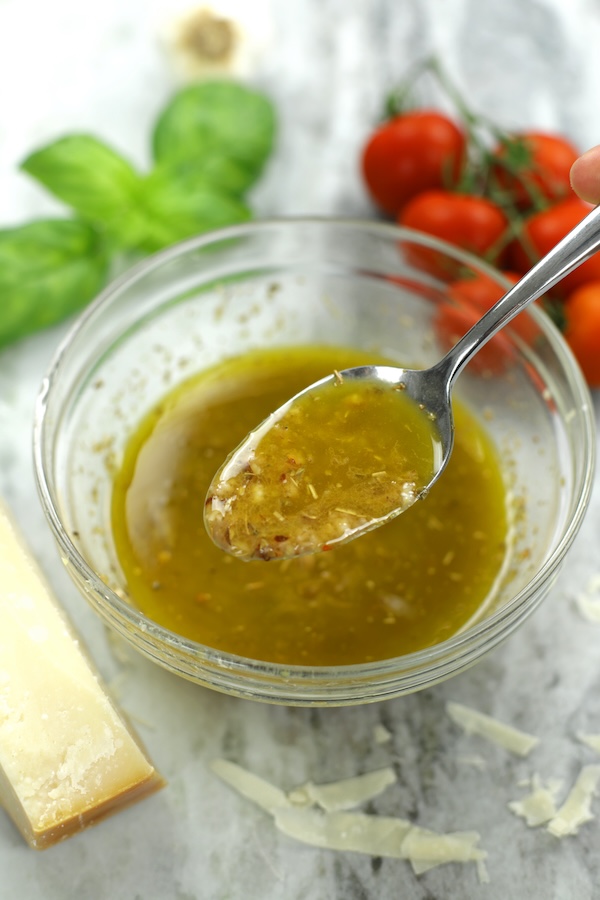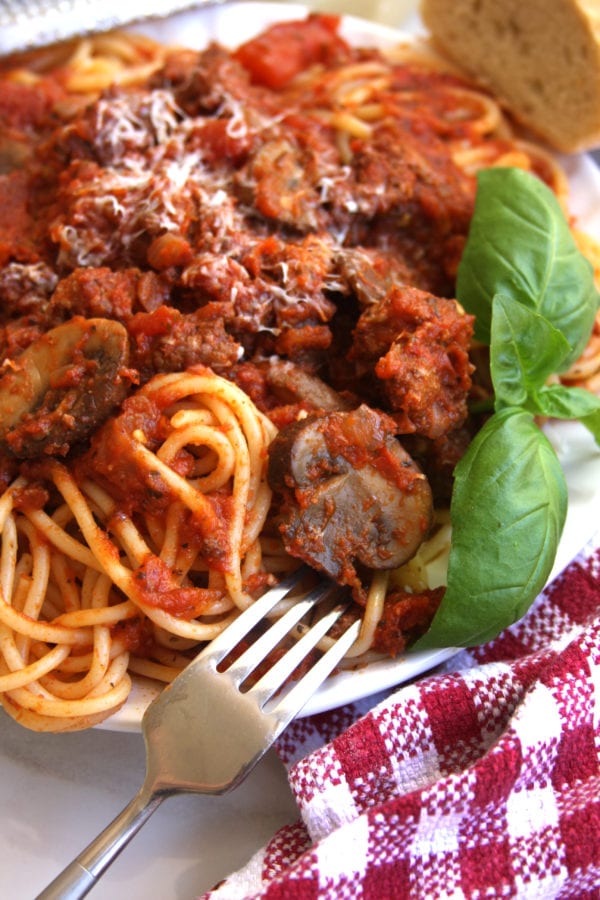Italian Vinaigrette
Homemade Italian Vinaigrette is a fresh and flavorful salad dressing made with extra virgin olive oil, Dijon mustard, garlic, and Italian herbs. A thousand times better than store bought and takes under 10 minutes to make.

This post may contain affiliate links which I earn a small portion in sales if a purchase is made. Rest assured though, it is never at any additional cost to you.

Tips for Beginners
If you are brand new to making homemade salad dressings, you are in for a treat. Not only are they incredibly easy to make, but they also taste far better than store-bought versions. Here are a few tips to help create mouthwatering vinaigrettes every time:
- Use Quality Ingredients– Fresh herbs (when appropriate), garlic, and high-quality oils, vinegars and dried herbs make a significant difference in flavor. Note: See the “Ingredients Needed” section below for some of my favorites.
- Emulsify Properly– A well emulsified dressing ensures consistent flavor and better coating of the lettuce and vegetables. In short, this helps to make the salad more enjoyable to eat. The good news, there are multiple ways to emulsify a salad dressing. Note: See the section “Different Ways to Emulsify a Vinaigrette” below for more details.
- Taste and Adjust– Always taste your vinaigrette before serving and adjust the seasoning as needed to satisfy individual taste preferences.
- Experiment– Don’t be afraid to experiment with different ingredients and ratios to find what you enjoy the most. Note: See the “Variations” section below.
- Store Properly– When making a larger batch of salad dressing, store the vinaigrette in a clean, airtight container in the refrigerator, and shake well before using to recombine the ingredients.
Ingredients Needed
- Extra Virgin Olive Oil– To pick a good quality extra virgin olive oil, look for one that is cold-pressed, has a harvest date within the past year, is stored in a dark glass bottle to protect from light, and has a certification seal from a reputable olive oil council.
- Lemon Juice– For juicy lemons, choose ones that are firm, heavy for their size, have a bright yellow color, and slightly glossy skin without any green spots or blemishes. To enhance the brightness of your vinaigrette, use both the lemon zest and juice. This is my favorite zester and juicer when making dressings.
- Red Wine Vinegar– Using both lemon juice and red wine vinegar in a homemade vinaigrette adds complexity. Lemon juice brings in a bright citrusy flavor while red wine vinegar adds a deeper fruity tang. This is one of my favorite affordable organic brands.
- Dijon Mustard– Dijon Mustard helps to emulsify the oil and vinegar together, while also giving the vinaigrette a slightly flavorful tang. This is my favorite Dijon brand, however I use the original flavor the most.
- Oregano– Dried oregano is highly convenient due to its extended shelf life compared to fresh oregano. However, if using fresh oregano, wash and dry the leaves thoroughly, then finely chop before whisking into the vinaigrette.
- Worcestershire Sauce– The secret ingredient that adds in a depth of umami flavor and a hint of tanginess.
- Fresh Garlic– I recommend using fresh garlic for its robust, delicious flavor that is far superior to jarred garlic. Additionally, for easy peeling try this quick tip and this tool for effortless processing.
- Red Chili Pepper Flakes (optional)– The addittion of red chili pepper flakes adds a spicy kick and depth of flavor to this vinaigrette. However, it is optional and is best to leave out for anyone who has more delicate taste buds.
- Salt– The addition of a good quality salt enhances the flavor of the vinaigrette and helps to balance the acidity and richness. My favorite high quality salts are Maldon’s Sea Salt and Celtic Sea Salt.
- Honey (optional)– Adding honey to a vinaigrette brings in a touch of sweetness that balances the acidity of the vinegar. This addition is optional and should be adjusted based on personal preference for sweetness in the dressing.
How To Make
- Add oil to a small bowl.
- Gradually whisk in lemon juice and red wine vinegar.
- Whisk in mustard until fully emulsified.
- Add remaining ingredients and continue whisking until well combined.
Different Ways To Emulsify a Vinaigrette
- Whisking Method– Gradually whisk in the acidic ingredients in a slow steady stream to the oil and continue whisking until emulsified. Add in the remaining ingredients and whisk well. This method is often done in a large bowl with the salad ingredients then being tossed in the vinaigrette.
- Shaking Method– Add all ingredients to a jar with a tight-fitting lid. Shake the jar vigorously until the vinaigrette is emulsified. This is a quick and easy method, especially useful for small batches.
- Blending Method– Place ingredients in a blender or food processor. Blend on high speed until the mixture is smooth and emulsified. This method is excellent for making larger batches or a very stable emulsification.
Variations
- Mediterranean Twist– Adding in finely chopped sun-dried tomatoes, capers and olives in addition to rosemary and basil brings in a delicious Mediterranean flair.
- Creamy Italian Dressing– Use this recipe as a base and add in Greek yogurt or mayonnaise for a creamy dressing.
- Herbs de Provence Twist– Replace dried oregano with Herbs de Provence for a unique French-inspired flavor profile. This herb blend typically includes thyme, savory, marjoram, rosemary, and lavender, which will add a floral and herbaceous complexity to your vinaigrette.
- Creamy Parmesan– Mix in grated Parmigiano-Reggiano (aka Parmesan cheese) and a spoonful of Greek yogurt for a creamy, cheesy vinaigrette. Note: Parmigiano-Reggiano is a premium Italian cheese renowned for its nutty flavor and granular texture, aged for at least 12 months to achieve its distinctive quality. Additionally, Costco has the best price on authentic Parmigiano-Reggiano.
Ways to Use Italian Vinaigrette
This vinaigrette is wonderful on green salads, Chopped Italian Salad or in wraps. However, here are a few other fun and delicious ways to use dressing:
- Marinade– Marinate vegetables, meats, or seafood before grilling or roasting to add a delicious flavor.
- Potato Salad– Toss it with warm potatoes for a flavorful potato salad.
- Pasta Salad– Use as a base for cold pasta salads.
- Grilled or Roasted Veggies– Drizzle over grilled or roasted veggies to enhance their natural flavor.
Frequently Asked Questions
How do I make garlic more mild in flavor?
To make garlic more mild in flavor, roast whole garlic cloves in the oven until they become soft and caramelized. Allow them to cool, then squeeze the roasted garlic out of the cloves and mash it into a paste before adding it to the vinaigrette. Roasting garlic mellows its sharpness and enhances its sweetness, resulting in a smoother and more subtle garlic flavor in the dressing.
If my vinaigrette tastes too acidic or too bland, how do I fix either?
To balance a vinaigrette that tastes too acidic, add a small amount of honey or maple syrup to sweeten it. If it tastes too bland, adjust by adding more salt, a splash of vinegar or lemon juice.
What helps to prevent separation with homemade vinaigrettes?
The best way to prevent separation in homemade vinaigrettes is to whisk or blend the ingredients thoroughly and use an emulsifier like Dijon mustard or honey, which helps bind the oil and vinegar together.
How long will this vinaigrette last?
This vinaigrette will typically last for about 1 to 2 weeks when stored in an airtight container in the refrigerator.
What is the best way to store a homemade vinaigrette?
The best way to store a homemade vinaigrette is in an airtight container, such as a glass jar or a salad dressing bottle with a tight-sealing lid, in the refrigerator.

Italian Vinaigrette
Ingredients
- 1/2 cup extra virgin olive oil
- 1/4 cup lemon juice
- 1/4 cup red wine vinegar
- 2 teaspoons Dijon mustard
- 1 tablespoon dried oregano *See Note #1 below
- 1 teaspoon Worcestershire sauce
- 1 tablespoon crushed garlic *or minced, about 4 large cloves
- 1 teaspoon crushed red chili pepper flakes *optional
- 1 teaspoon salt
- 1 teaspoon honey *optional
Instructions
- To a small bowl add oil. Gradually whisk in lemon juice and red wine vinegar.
- Whisk in mustard until fully emulsified. See Note #2 below.
- Add remaining ingredients and continue whisking until fully incorporated.






